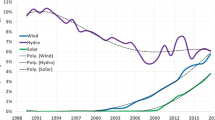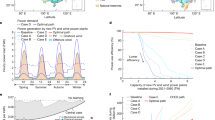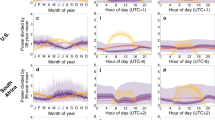Abstract
Previous studies have demonstrated the possibility of maintaining a reliable electric power system with high shares of renewables, but only assuming the deployment of specific technologies in precise ratios, careful demand-side management, or grid-scale storage technologies1,2. Any scalable renewable technology that could provide either baseload or dispatchable power would allow greater flexibility in planning a balanced system, and therefore would be especially valuable. Many analysts have suggested that concentrating solar power (CSP) could do just that3,4,5,6,7,8. Here we systematically test this proposition for the first time. We simulate the operation of CSP plant networks incorporating thermal storage in four world regions where CSP is already being deployed, and optimize their siting, operation and sizing to satisfy a set of realistic demand scenarios. In all four regions, we show that with an optimally designed and operated system, it is possible to guarantee up to half of peak capacity before CSP plant costs substantially increase.
This is a preview of subscription content, access via your institution
Access options
Subscribe to this journal
Receive 12 print issues and online access
$209.00 per year
only $17.42 per issue
Buy this article
- Purchase on Springer Link
- Instant access to full article PDF
Prices may be subject to local taxes which are calculated during checkout



Similar content being viewed by others
References
Ekman, C. K. & Jensen, S. H. Prospects for large scale electricity storage in Denmark. Energy Convers. Manage. 51, 1140–1147 (2010).
Mathiesen, B. V. & Lund, H. Comparative analyses of seven technologies to facilitate the integration of fluctuating renewable energy sources. IET Renew. Power Gen. 3, 190–204 (2009).
Usaola, J. Operation of concentrating solar power plants with storage in spot electricity markets. IET Renew. Power Gen. 6, 59–66 (2012).
Trieb, F., Schillings, C., Pregger, T. & O’Sullivan, M. Solar electricity imports from the Middle East and North Africa to Europe. Energy Policy 42, 341–353 (2012).
Izquierdo, S., Montañés, C., Dopazo, C. & Fueyo, N. Analysis of CSP plants for the definition of energy policies: The influence on electricity cost of solar multiples, capacity factors and energy storage. Energy Policy 38, 6215–6221 (2010).
Lilliestam, J., Bielicki, J. & Patt, A. Comparing carbon capture and storage (CCS) with concentrating solar power (CSP): Potentials, costs, risks, and barriers. Energy Policy 47, 447–455 (2012).
Fthenakis, V., Mason, J. & Zweibel, K. The technical, geographical, and economic feasibility for solar energy to supply the energy needs of the US. Energy Policy 37, 387–399 (2009).
Viehbahn, P., Lechon, Y. & Trieb, F. The potential role of concentrated solar power (CSP) in Africa and Europe. Energy Policy 39, 4420–4430 (2011).
McCollum, D., Yang, C., Yeh, S. & Ogden, J. Deep greenhouse gas reduction scenarios for California—Strategic implications from the CA-TIMES energy-economic systems model. Energy Strategy Rev. 1, 19–32 (2012).
Lilliestam, J. et al. An alternative to a global climate deal may be unfolding before our eyes. Clim. Dev. 4, 1–4 (2012).
EC Energy Roadmap 2050 COM(2011) 885/2 (European Commission, 2011).
State of California. Executive Order S-3-05 (The Governor of California, 2005).
Haller, M., Ludig, S. & Bauer, N. Decarbonisation scenarios for the EU and MENA power system: Considering spatial distribution and short term dynamics of renewable generation. Energy Policy 47, 282–290 (2012).
IPCC, Special Report on Renewable Energy Sources and Climate Change Mitigation (Cambridge Univ. Press, 2011).
Delucchi, M. A. & Jacobson, M. Z. Providing all global energy with wind, water, and solar power, Part II: Reliability, system and transmisison costs, and policies. Energy Policy 39, 1170–1190 (2011).
Jacobson, M. Z. & Delucchi, M. A. Providing all global energy with wind, water, and solar power, Part I: Technologies, energy resources, quantities and areas of infrastructure, and materials. Energy Policy 39, 1154–1169 (2011).
Garrison, J. B. & Webber, M. E. An integrated energy storage scheme for a dispatchable solar and wind powered energy system. J. Renew. Sustain. Energy 3, 043101 (2011).
Heide, D., Greiner, M., von Bremen, L. & Hoffmann, C. Reduced storage and balancing needs in a fully renewable European power system with excess wind and solar power generation. Renew. Energy 36, 2515–2523 (2011).
Budischak, C. et al. Cost-minimized combinations of wind power, solar power and electrochemical storage, powering the grid up to 99.9% of the time. J. Power Sources 225, 60–74 (2013).
Arent, D. et al. Implications of high renewable electricity penetration in the U.S. for water use, greenhouse gas emissions, land-use, and materials supply. Appl. Energy 123, 368–377 (2014).
Patt, A., Komendantova, N., Battaglini, A. & Lilliestam, J. Regional integration to support full renewable power deployment for Europe by 2050. Environ. Politics 20, 727–742 (2011).
Battaglini, A., Lilliestam, J., Haas, A. & Patt, A. Development of SuperSmart Grids for a more efficient utilisation of electricity from renewable sources. J. Cleaner Prod. 17, 911–918 (2009).
Katzenstein, W., Fertig, E. & Apt, J. The variability of interconnected wind plants. Energy Policy 38, 4400–4410 (2010).
Kempton, W., Pimenta, F. M., Veron, D. E. & Colle, B. A. Electric power from offshore wind via synoptic-scale interconnection. Proc. Natl Acad. Sci. USA 107, 7240–7245 (2010).
IAEA Nuclear Power Reactors in the World 2011 Edition (International Atomic Energy Agency, 2011).
Förster, H. & Lilliestam, J. Modeling thermoelectric power generation in view of climate change. Reg. Environ. Change 10, 327–338 (2010).
Van Vliet, M. T. H. et al. Vulnerability of US and European electricity supply to climate change. Nature Clim. Change 2, 676–681 (2012).
Gauché, P., von Backström, T. W. & Brent, A. C. 17th SolarPACES Conference 20–23 (2011).
Acknowledgements
Funding for this work was provided by the Grantham Institute for Climate Change, the European Institute of Innovation and Technology via its Climate-KIC program, and derived from the European Research Council, grant number 313533.
Author information
Authors and Affiliations
Contributions
S.P., J.L. and A.P. designed the study and drafted the manuscript. S.P. implemented the models and performed all analyses. P.G. contributed the CSP plant model and solar resource data. K.D. performed the site selection and obtained demand data. F.W. contributed to model development and implementation. All authors contributed to editing and discussing the manuscript.
Corresponding author
Ethics declarations
Competing interests
The authors declare no competing financial interests.
Supplementary information
Rights and permissions
About this article
Cite this article
Pfenninger, S., Gauché, P., Lilliestam, J. et al. Potential for concentrating solar power to provide baseload and dispatchable power. Nature Clim Change 4, 689–692 (2014). https://doi.org/10.1038/nclimate2276
Received:
Accepted:
Published:
Issue Date:
DOI: https://doi.org/10.1038/nclimate2276
This article is cited by
-
Opportunities and challenges of baseload solar electricity
Journal of the Brazilian Society of Mechanical Sciences and Engineering (2024)
-
Effect of thermal treatment on physical and mechanical properties of sandstone for thermal energy storage: a comprehensive experimental study
Acta Geotechnica (2022)
-
Will policies to promote energy efficiency help or hinder achieving a 1.5 °C climate target?
Energy Efficiency (2019)
-
Ceramic–metal composites for heat exchangers in concentrated solar power plants
Nature (2018)
-
Balancing Europe’s wind-power output through spatial deployment informed by weather regimes
Nature Climate Change (2017)



